ECF6105 Semester 2: Analyzing Vulgar Graffiti Using Externality Theory
VerifiedAdded on 2023/06/04
|10
|1626
|250
Essay
AI Summary
This essay examines the economic implications of vulgar graffiti sprayed on the roads and footpaths of South Street, utilizing the conceptual framework of externality theory. It defines externality as the impact of production or consumption on third parties and distinguishes between positive and negative externalities in both production and consumption. The essay argues that vulgar graffiti creates a negative externality, imposing costs on viewers and the municipality responsible for cleanup. It proposes policy solutions, such as fines and non-monetary punishments for those creating the graffiti, with the revenue used for cleanup and security. The analysis concludes that these measures can reduce the incidence of vulgar graffiti by increasing the cost and risk for perpetrators, ultimately leading to a socially optimal level of graffiti that is lower than the current free market level. Desklib provides students access to similar solved assignments and past papers for academic support.
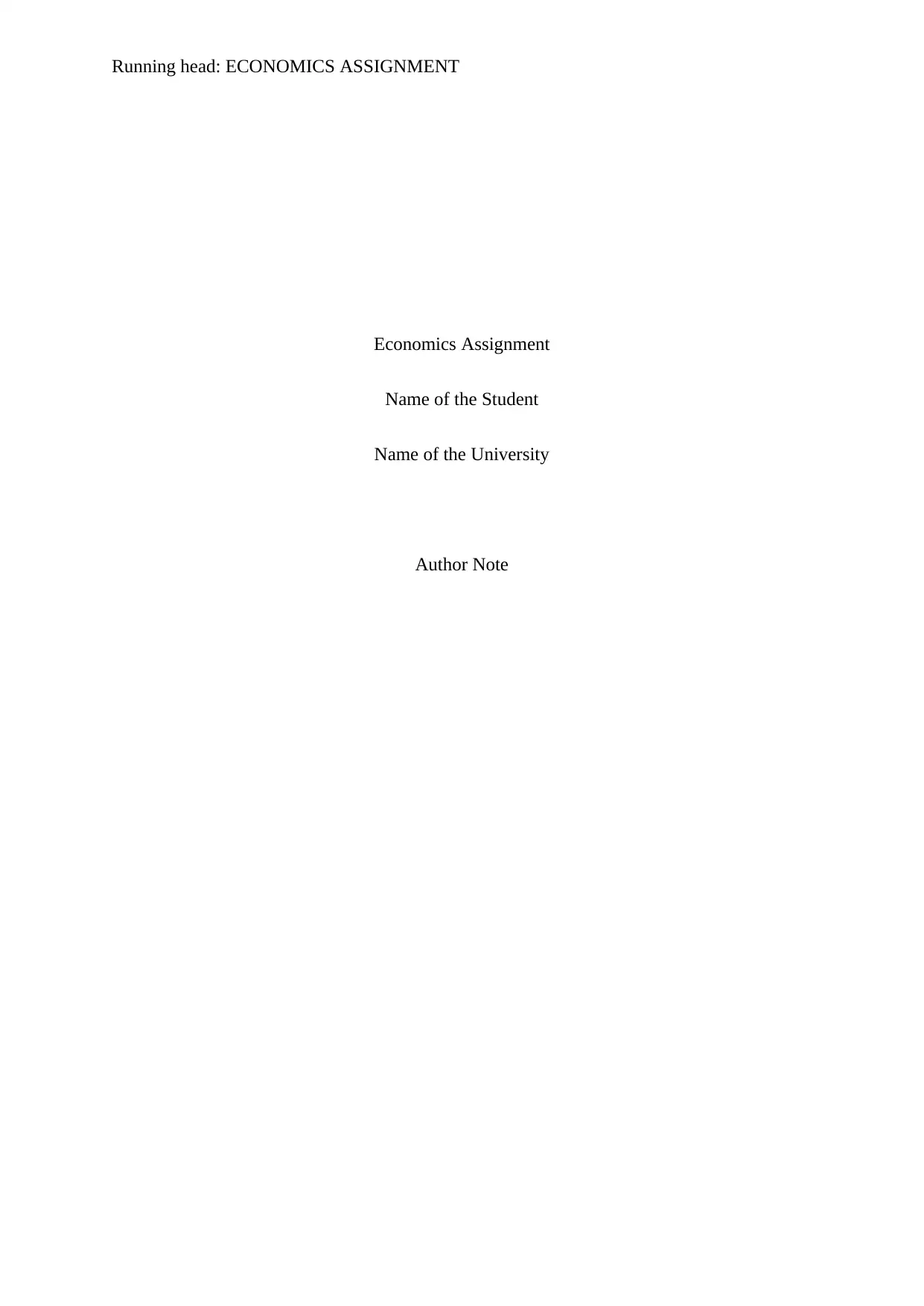
Running head: ECONOMICS ASSIGNMENT
Economics Assignment
Name of the Student
Name of the University
Author Note
Economics Assignment
Name of the Student
Name of the University
Author Note
Paraphrase This Document
Need a fresh take? Get an instant paraphrase of this document with our AI Paraphraser
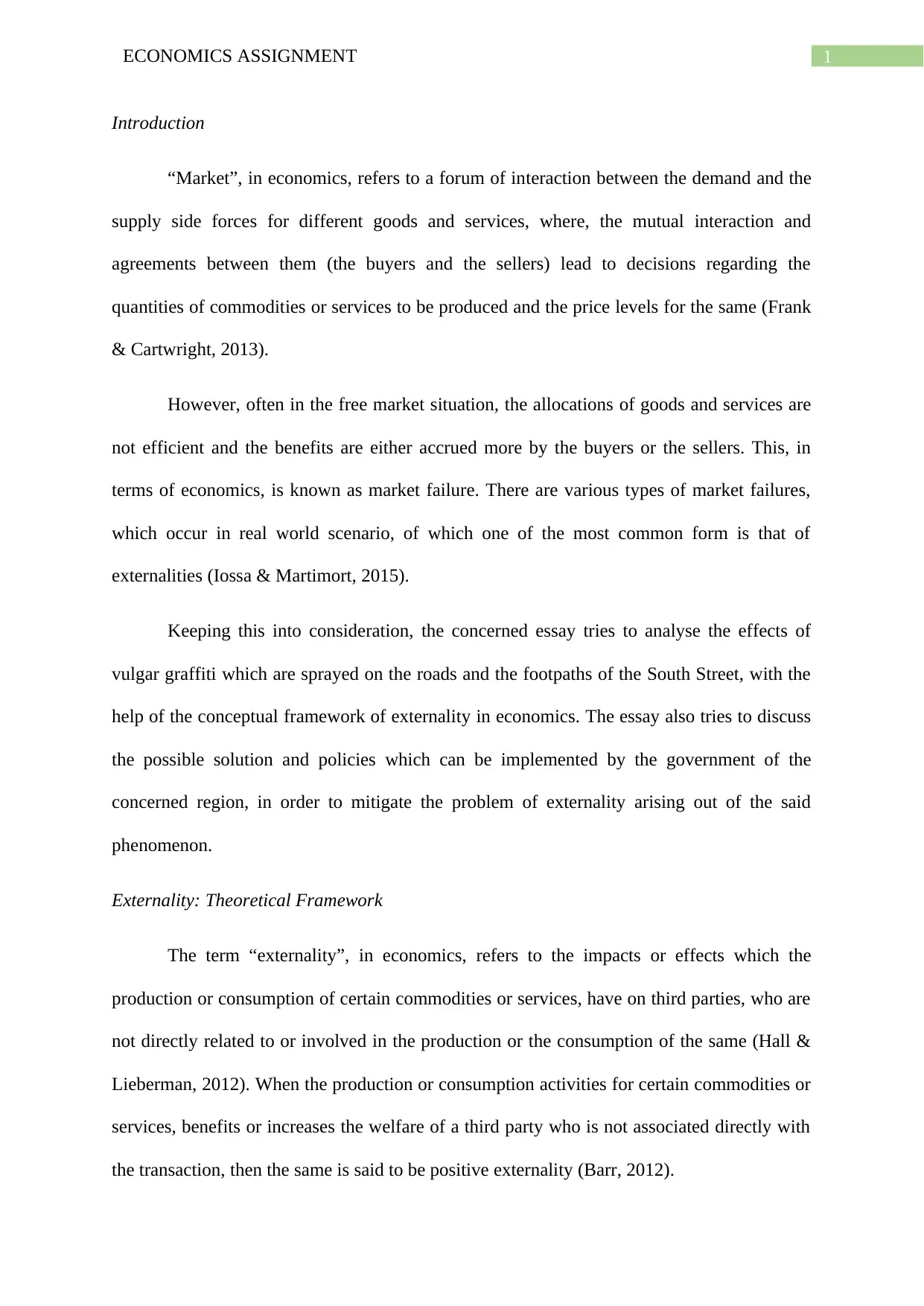
1ECONOMICS ASSIGNMENT
Introduction
“Market”, in economics, refers to a forum of interaction between the demand and the
supply side forces for different goods and services, where, the mutual interaction and
agreements between them (the buyers and the sellers) lead to decisions regarding the
quantities of commodities or services to be produced and the price levels for the same (Frank
& Cartwright, 2013).
However, often in the free market situation, the allocations of goods and services are
not efficient and the benefits are either accrued more by the buyers or the sellers. This, in
terms of economics, is known as market failure. There are various types of market failures,
which occur in real world scenario, of which one of the most common form is that of
externalities (Iossa & Martimort, 2015).
Keeping this into consideration, the concerned essay tries to analyse the effects of
vulgar graffiti which are sprayed on the roads and the footpaths of the South Street, with the
help of the conceptual framework of externality in economics. The essay also tries to discuss
the possible solution and policies which can be implemented by the government of the
concerned region, in order to mitigate the problem of externality arising out of the said
phenomenon.
Externality: Theoretical Framework
The term “externality”, in economics, refers to the impacts or effects which the
production or consumption of certain commodities or services, have on third parties, who are
not directly related to or involved in the production or the consumption of the same (Hall &
Lieberman, 2012). When the production or consumption activities for certain commodities or
services, benefits or increases the welfare of a third party who is not associated directly with
the transaction, then the same is said to be positive externality (Barr, 2012).
Introduction
“Market”, in economics, refers to a forum of interaction between the demand and the
supply side forces for different goods and services, where, the mutual interaction and
agreements between them (the buyers and the sellers) lead to decisions regarding the
quantities of commodities or services to be produced and the price levels for the same (Frank
& Cartwright, 2013).
However, often in the free market situation, the allocations of goods and services are
not efficient and the benefits are either accrued more by the buyers or the sellers. This, in
terms of economics, is known as market failure. There are various types of market failures,
which occur in real world scenario, of which one of the most common form is that of
externalities (Iossa & Martimort, 2015).
Keeping this into consideration, the concerned essay tries to analyse the effects of
vulgar graffiti which are sprayed on the roads and the footpaths of the South Street, with the
help of the conceptual framework of externality in economics. The essay also tries to discuss
the possible solution and policies which can be implemented by the government of the
concerned region, in order to mitigate the problem of externality arising out of the said
phenomenon.
Externality: Theoretical Framework
The term “externality”, in economics, refers to the impacts or effects which the
production or consumption of certain commodities or services, have on third parties, who are
not directly related to or involved in the production or the consumption of the same (Hall &
Lieberman, 2012). When the production or consumption activities for certain commodities or
services, benefits or increases the welfare of a third party who is not associated directly with
the transaction, then the same is said to be positive externality (Barr, 2012).
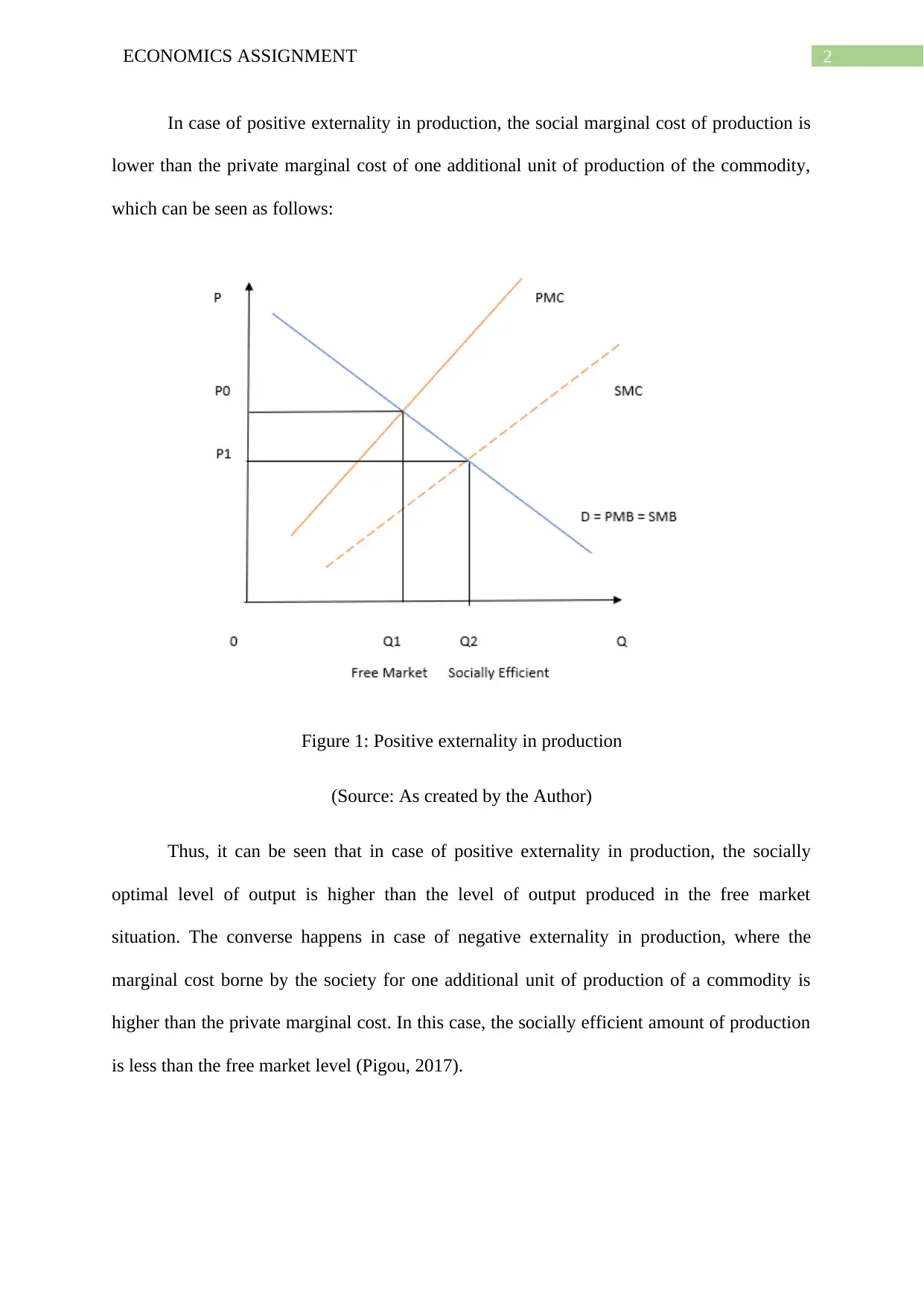
2ECONOMICS ASSIGNMENT
In case of positive externality in production, the social marginal cost of production is
lower than the private marginal cost of one additional unit of production of the commodity,
which can be seen as follows:
Figure 1: Positive externality in production
(Source: As created by the Author)
Thus, it can be seen that in case of positive externality in production, the socially
optimal level of output is higher than the level of output produced in the free market
situation. The converse happens in case of negative externality in production, where the
marginal cost borne by the society for one additional unit of production of a commodity is
higher than the private marginal cost. In this case, the socially efficient amount of production
is less than the free market level (Pigou, 2017).
In case of positive externality in production, the social marginal cost of production is
lower than the private marginal cost of one additional unit of production of the commodity,
which can be seen as follows:
Figure 1: Positive externality in production
(Source: As created by the Author)
Thus, it can be seen that in case of positive externality in production, the socially
optimal level of output is higher than the level of output produced in the free market
situation. The converse happens in case of negative externality in production, where the
marginal cost borne by the society for one additional unit of production of a commodity is
higher than the private marginal cost. In this case, the socially efficient amount of production
is less than the free market level (Pigou, 2017).
⊘ This is a preview!⊘
Do you want full access?
Subscribe today to unlock all pages.

Trusted by 1+ million students worldwide
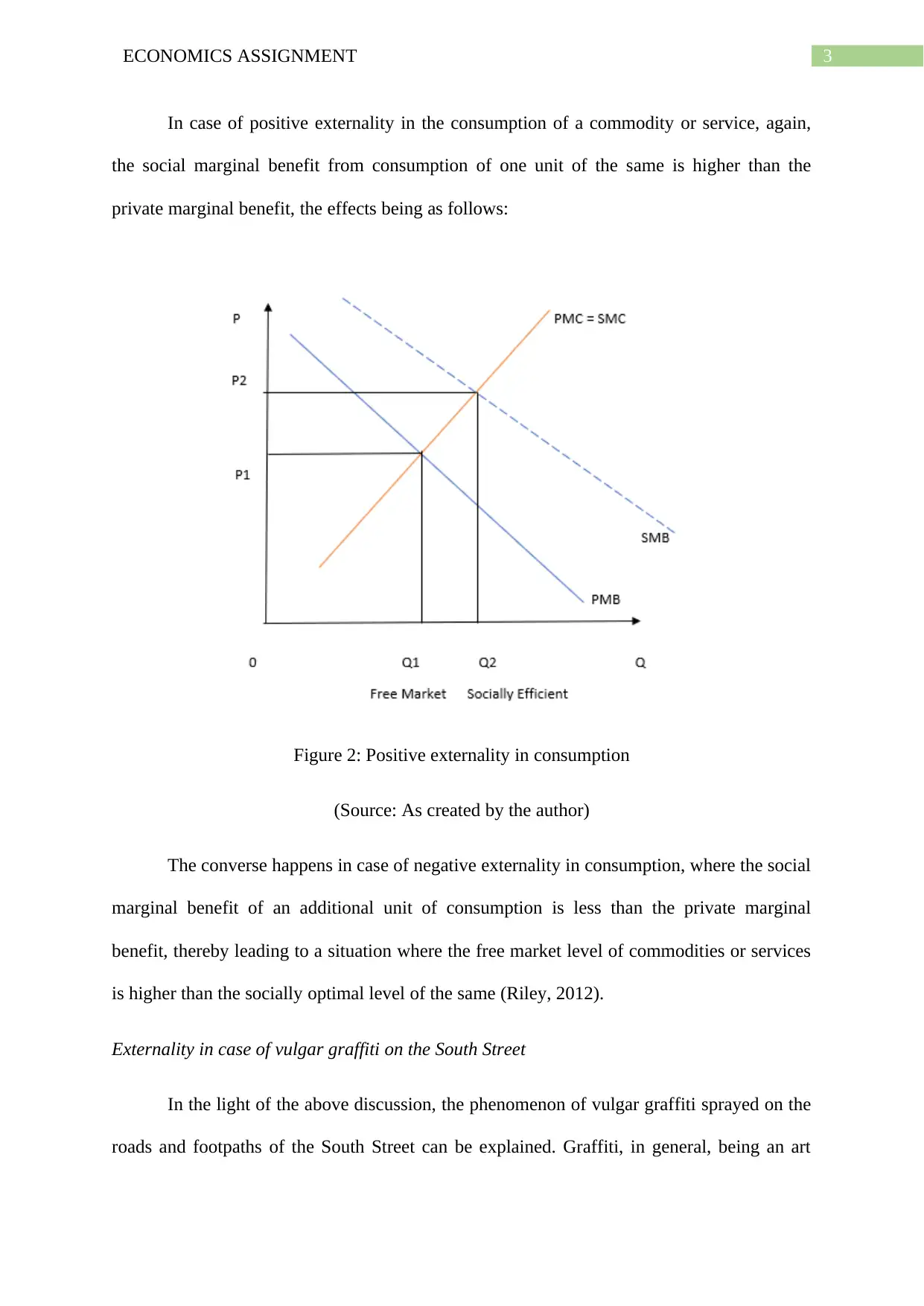
3ECONOMICS ASSIGNMENT
In case of positive externality in the consumption of a commodity or service, again,
the social marginal benefit from consumption of one unit of the same is higher than the
private marginal benefit, the effects being as follows:
Figure 2: Positive externality in consumption
(Source: As created by the author)
The converse happens in case of negative externality in consumption, where the social
marginal benefit of an additional unit of consumption is less than the private marginal
benefit, thereby leading to a situation where the free market level of commodities or services
is higher than the socially optimal level of the same (Riley, 2012).
Externality in case of vulgar graffiti on the South Street
In the light of the above discussion, the phenomenon of vulgar graffiti sprayed on the
roads and footpaths of the South Street can be explained. Graffiti, in general, being an art
In case of positive externality in the consumption of a commodity or service, again,
the social marginal benefit from consumption of one unit of the same is higher than the
private marginal benefit, the effects being as follows:
Figure 2: Positive externality in consumption
(Source: As created by the author)
The converse happens in case of negative externality in consumption, where the social
marginal benefit of an additional unit of consumption is less than the private marginal
benefit, thereby leading to a situation where the free market level of commodities or services
is higher than the socially optimal level of the same (Riley, 2012).
Externality in case of vulgar graffiti on the South Street
In the light of the above discussion, the phenomenon of vulgar graffiti sprayed on the
roads and footpaths of the South Street can be explained. Graffiti, in general, being an art
Paraphrase This Document
Need a fresh take? Get an instant paraphrase of this document with our AI Paraphraser
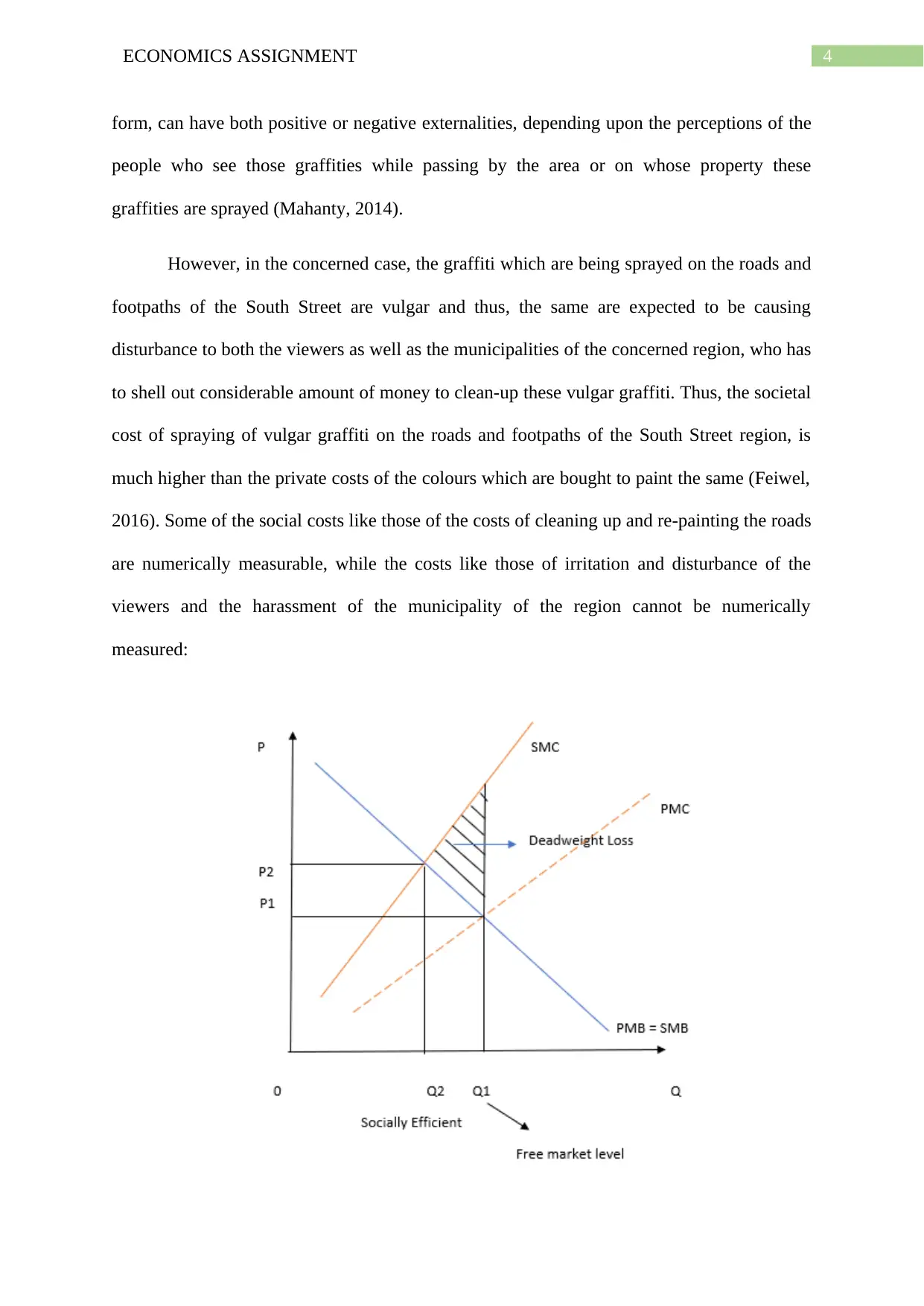
4ECONOMICS ASSIGNMENT
form, can have both positive or negative externalities, depending upon the perceptions of the
people who see those graffities while passing by the area or on whose property these
graffities are sprayed (Mahanty, 2014).
However, in the concerned case, the graffiti which are being sprayed on the roads and
footpaths of the South Street are vulgar and thus, the same are expected to be causing
disturbance to both the viewers as well as the municipalities of the concerned region, who has
to shell out considerable amount of money to clean-up these vulgar graffiti. Thus, the societal
cost of spraying of vulgar graffiti on the roads and footpaths of the South Street region, is
much higher than the private costs of the colours which are bought to paint the same (Feiwel,
2016). Some of the social costs like those of the costs of cleaning up and re-painting the roads
are numerically measurable, while the costs like those of irritation and disturbance of the
viewers and the harassment of the municipality of the region cannot be numerically
measured:
form, can have both positive or negative externalities, depending upon the perceptions of the
people who see those graffities while passing by the area or on whose property these
graffities are sprayed (Mahanty, 2014).
However, in the concerned case, the graffiti which are being sprayed on the roads and
footpaths of the South Street are vulgar and thus, the same are expected to be causing
disturbance to both the viewers as well as the municipalities of the concerned region, who has
to shell out considerable amount of money to clean-up these vulgar graffiti. Thus, the societal
cost of spraying of vulgar graffiti on the roads and footpaths of the South Street region, is
much higher than the private costs of the colours which are bought to paint the same (Feiwel,
2016). Some of the social costs like those of the costs of cleaning up and re-painting the roads
are numerically measurable, while the costs like those of irritation and disturbance of the
viewers and the harassment of the municipality of the region cannot be numerically
measured:
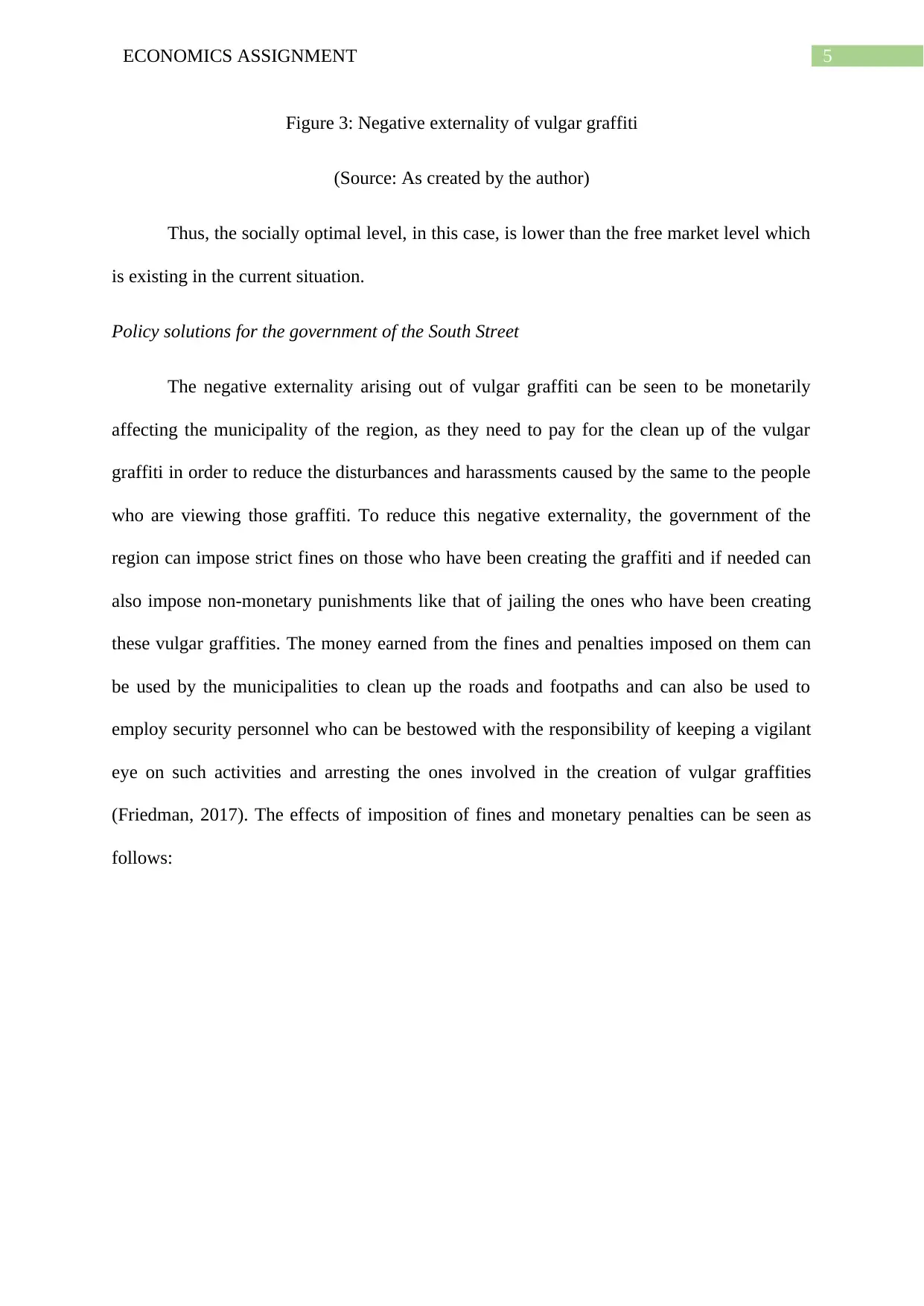
5ECONOMICS ASSIGNMENT
Figure 3: Negative externality of vulgar graffiti
(Source: As created by the author)
Thus, the socially optimal level, in this case, is lower than the free market level which
is existing in the current situation.
Policy solutions for the government of the South Street
The negative externality arising out of vulgar graffiti can be seen to be monetarily
affecting the municipality of the region, as they need to pay for the clean up of the vulgar
graffiti in order to reduce the disturbances and harassments caused by the same to the people
who are viewing those graffiti. To reduce this negative externality, the government of the
region can impose strict fines on those who have been creating the graffiti and if needed can
also impose non-monetary punishments like that of jailing the ones who have been creating
these vulgar graffities. The money earned from the fines and penalties imposed on them can
be used by the municipalities to clean up the roads and footpaths and can also be used to
employ security personnel who can be bestowed with the responsibility of keeping a vigilant
eye on such activities and arresting the ones involved in the creation of vulgar graffities
(Friedman, 2017). The effects of imposition of fines and monetary penalties can be seen as
follows:
Figure 3: Negative externality of vulgar graffiti
(Source: As created by the author)
Thus, the socially optimal level, in this case, is lower than the free market level which
is existing in the current situation.
Policy solutions for the government of the South Street
The negative externality arising out of vulgar graffiti can be seen to be monetarily
affecting the municipality of the region, as they need to pay for the clean up of the vulgar
graffiti in order to reduce the disturbances and harassments caused by the same to the people
who are viewing those graffiti. To reduce this negative externality, the government of the
region can impose strict fines on those who have been creating the graffiti and if needed can
also impose non-monetary punishments like that of jailing the ones who have been creating
these vulgar graffities. The money earned from the fines and penalties imposed on them can
be used by the municipalities to clean up the roads and footpaths and can also be used to
employ security personnel who can be bestowed with the responsibility of keeping a vigilant
eye on such activities and arresting the ones involved in the creation of vulgar graffities
(Friedman, 2017). The effects of imposition of fines and monetary penalties can be seen as
follows:
⊘ This is a preview!⊘
Do you want full access?
Subscribe today to unlock all pages.

Trusted by 1+ million students worldwide
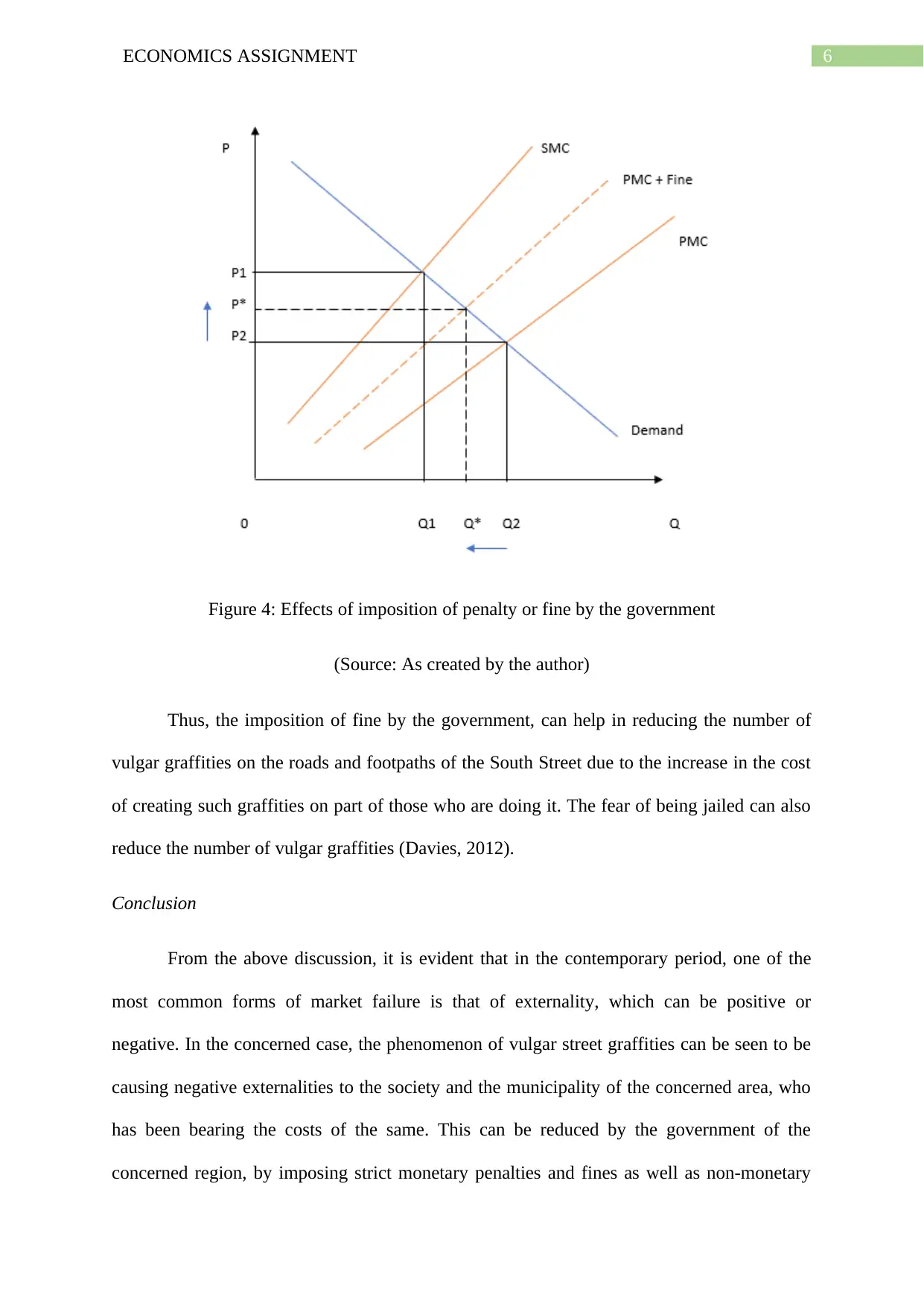
6ECONOMICS ASSIGNMENT
Figure 4: Effects of imposition of penalty or fine by the government
(Source: As created by the author)
Thus, the imposition of fine by the government, can help in reducing the number of
vulgar graffities on the roads and footpaths of the South Street due to the increase in the cost
of creating such graffities on part of those who are doing it. The fear of being jailed can also
reduce the number of vulgar graffities (Davies, 2012).
Conclusion
From the above discussion, it is evident that in the contemporary period, one of the
most common forms of market failure is that of externality, which can be positive or
negative. In the concerned case, the phenomenon of vulgar street graffities can be seen to be
causing negative externalities to the society and the municipality of the concerned area, who
has been bearing the costs of the same. This can be reduced by the government of the
concerned region, by imposing strict monetary penalties and fines as well as non-monetary
Figure 4: Effects of imposition of penalty or fine by the government
(Source: As created by the author)
Thus, the imposition of fine by the government, can help in reducing the number of
vulgar graffities on the roads and footpaths of the South Street due to the increase in the cost
of creating such graffities on part of those who are doing it. The fear of being jailed can also
reduce the number of vulgar graffities (Davies, 2012).
Conclusion
From the above discussion, it is evident that in the contemporary period, one of the
most common forms of market failure is that of externality, which can be positive or
negative. In the concerned case, the phenomenon of vulgar street graffities can be seen to be
causing negative externalities to the society and the municipality of the concerned area, who
has been bearing the costs of the same. This can be reduced by the government of the
concerned region, by imposing strict monetary penalties and fines as well as non-monetary
Paraphrase This Document
Need a fresh take? Get an instant paraphrase of this document with our AI Paraphraser
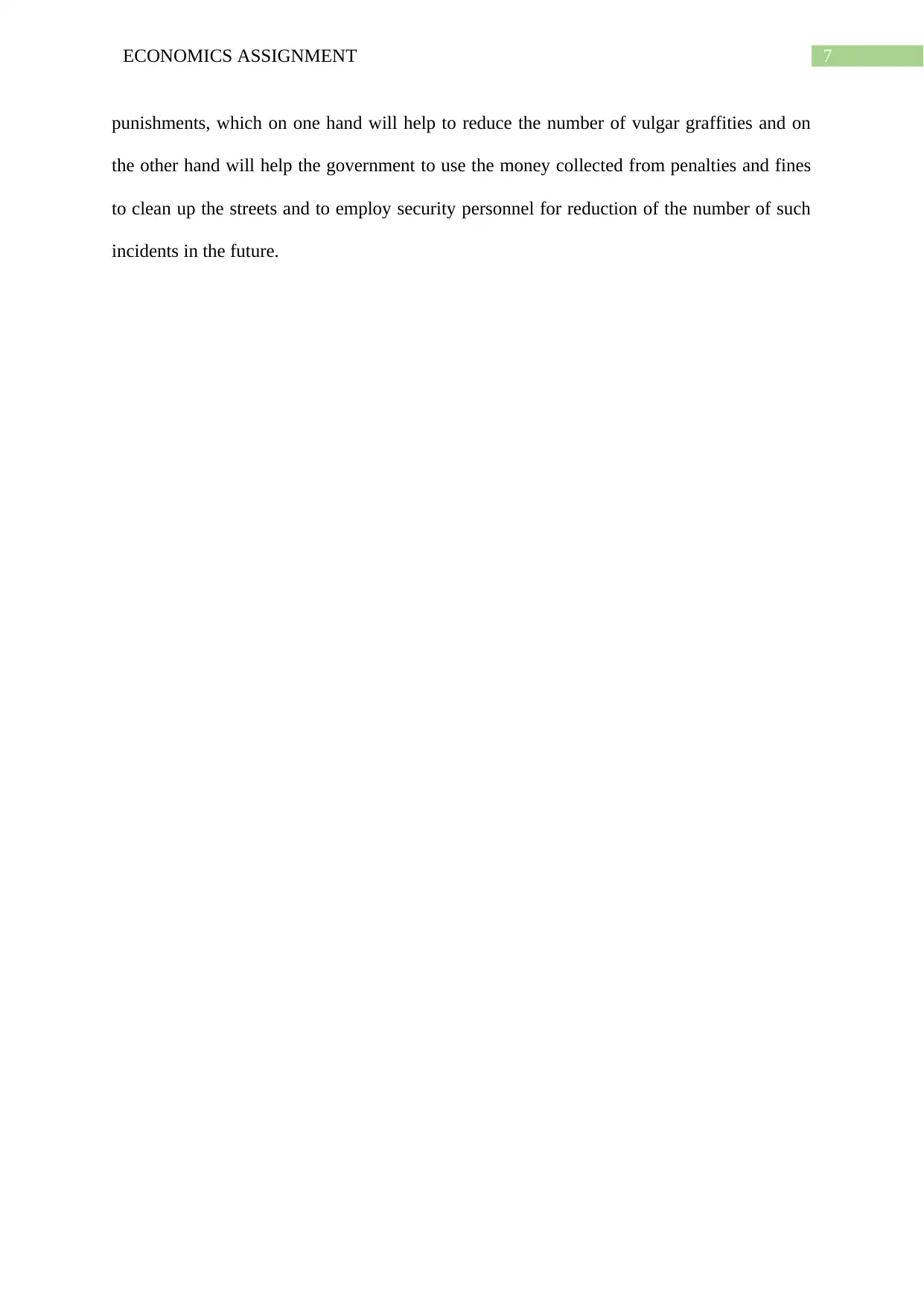
7ECONOMICS ASSIGNMENT
punishments, which on one hand will help to reduce the number of vulgar graffities and on
the other hand will help the government to use the money collected from penalties and fines
to clean up the streets and to employ security personnel for reduction of the number of such
incidents in the future.
punishments, which on one hand will help to reduce the number of vulgar graffities and on
the other hand will help the government to use the money collected from penalties and fines
to clean up the streets and to employ security personnel for reduction of the number of such
incidents in the future.
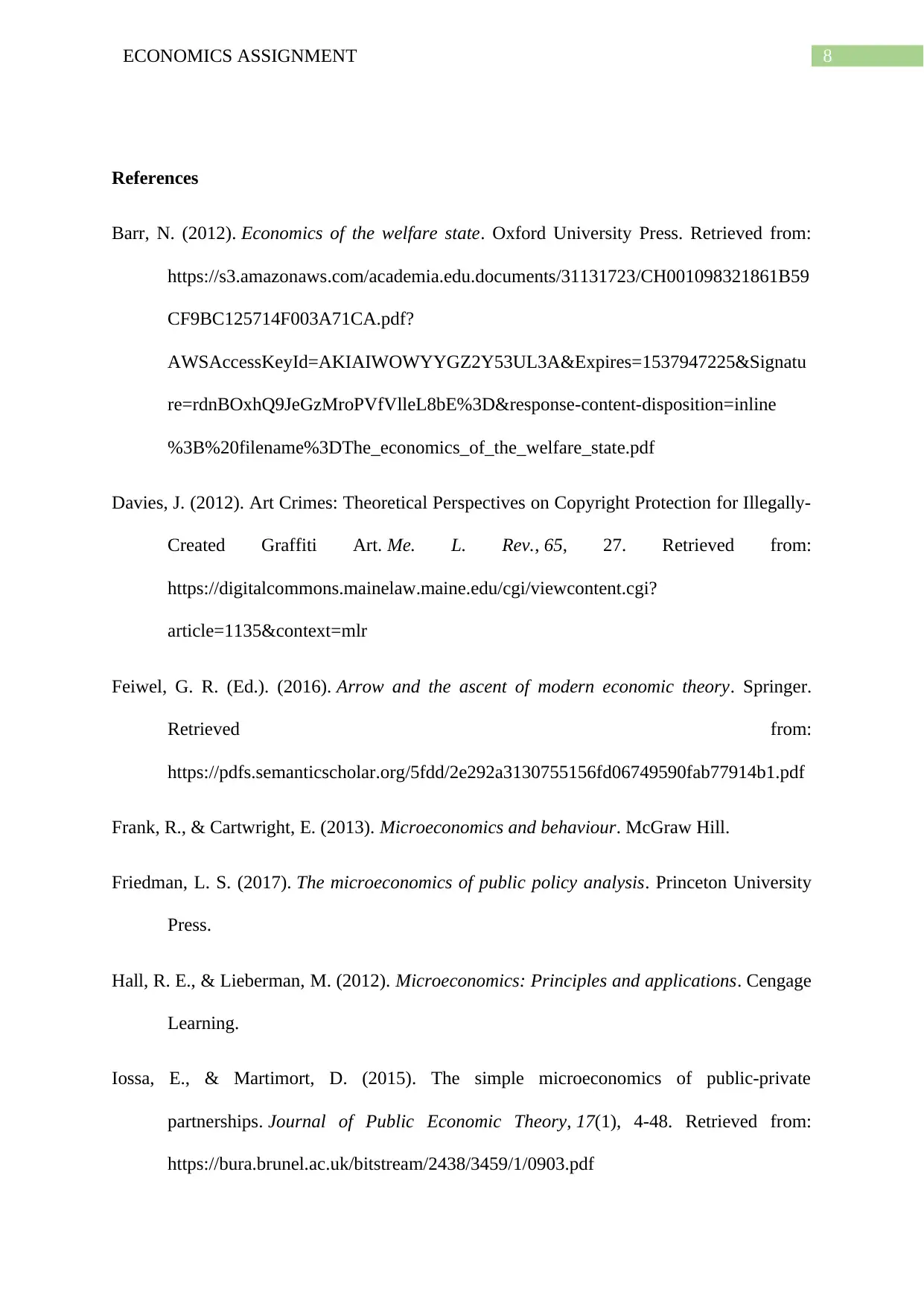
8ECONOMICS ASSIGNMENT
References
Barr, N. (2012). Economics of the welfare state. Oxford University Press. Retrieved from:
https://s3.amazonaws.com/academia.edu.documents/31131723/CH001098321861B59
CF9BC125714F003A71CA.pdf?
AWSAccessKeyId=AKIAIWOWYYGZ2Y53UL3A&Expires=1537947225&Signatu
re=rdnBOxhQ9JeGzMroPVfVlleL8bE%3D&response-content-disposition=inline
%3B%20filename%3DThe_economics_of_the_welfare_state.pdf
Davies, J. (2012). Art Crimes: Theoretical Perspectives on Copyright Protection for Illegally-
Created Graffiti Art. Me. L. Rev., 65, 27. Retrieved from:
https://digitalcommons.mainelaw.maine.edu/cgi/viewcontent.cgi?
article=1135&context=mlr
Feiwel, G. R. (Ed.). (2016). Arrow and the ascent of modern economic theory. Springer.
Retrieved from:
https://pdfs.semanticscholar.org/5fdd/2e292a3130755156fd06749590fab77914b1.pdf
Frank, R., & Cartwright, E. (2013). Microeconomics and behaviour. McGraw Hill.
Friedman, L. S. (2017). The microeconomics of public policy analysis. Princeton University
Press.
Hall, R. E., & Lieberman, M. (2012). Microeconomics: Principles and applications. Cengage
Learning.
Iossa, E., & Martimort, D. (2015). The simple microeconomics of public‐private
partnerships. Journal of Public Economic Theory, 17(1), 4-48. Retrieved from:
https://bura.brunel.ac.uk/bitstream/2438/3459/1/0903.pdf
References
Barr, N. (2012). Economics of the welfare state. Oxford University Press. Retrieved from:
https://s3.amazonaws.com/academia.edu.documents/31131723/CH001098321861B59
CF9BC125714F003A71CA.pdf?
AWSAccessKeyId=AKIAIWOWYYGZ2Y53UL3A&Expires=1537947225&Signatu
re=rdnBOxhQ9JeGzMroPVfVlleL8bE%3D&response-content-disposition=inline
%3B%20filename%3DThe_economics_of_the_welfare_state.pdf
Davies, J. (2012). Art Crimes: Theoretical Perspectives on Copyright Protection for Illegally-
Created Graffiti Art. Me. L. Rev., 65, 27. Retrieved from:
https://digitalcommons.mainelaw.maine.edu/cgi/viewcontent.cgi?
article=1135&context=mlr
Feiwel, G. R. (Ed.). (2016). Arrow and the ascent of modern economic theory. Springer.
Retrieved from:
https://pdfs.semanticscholar.org/5fdd/2e292a3130755156fd06749590fab77914b1.pdf
Frank, R., & Cartwright, E. (2013). Microeconomics and behaviour. McGraw Hill.
Friedman, L. S. (2017). The microeconomics of public policy analysis. Princeton University
Press.
Hall, R. E., & Lieberman, M. (2012). Microeconomics: Principles and applications. Cengage
Learning.
Iossa, E., & Martimort, D. (2015). The simple microeconomics of public‐private
partnerships. Journal of Public Economic Theory, 17(1), 4-48. Retrieved from:
https://bura.brunel.ac.uk/bitstream/2438/3459/1/0903.pdf
⊘ This is a preview!⊘
Do you want full access?
Subscribe today to unlock all pages.

Trusted by 1+ million students worldwide
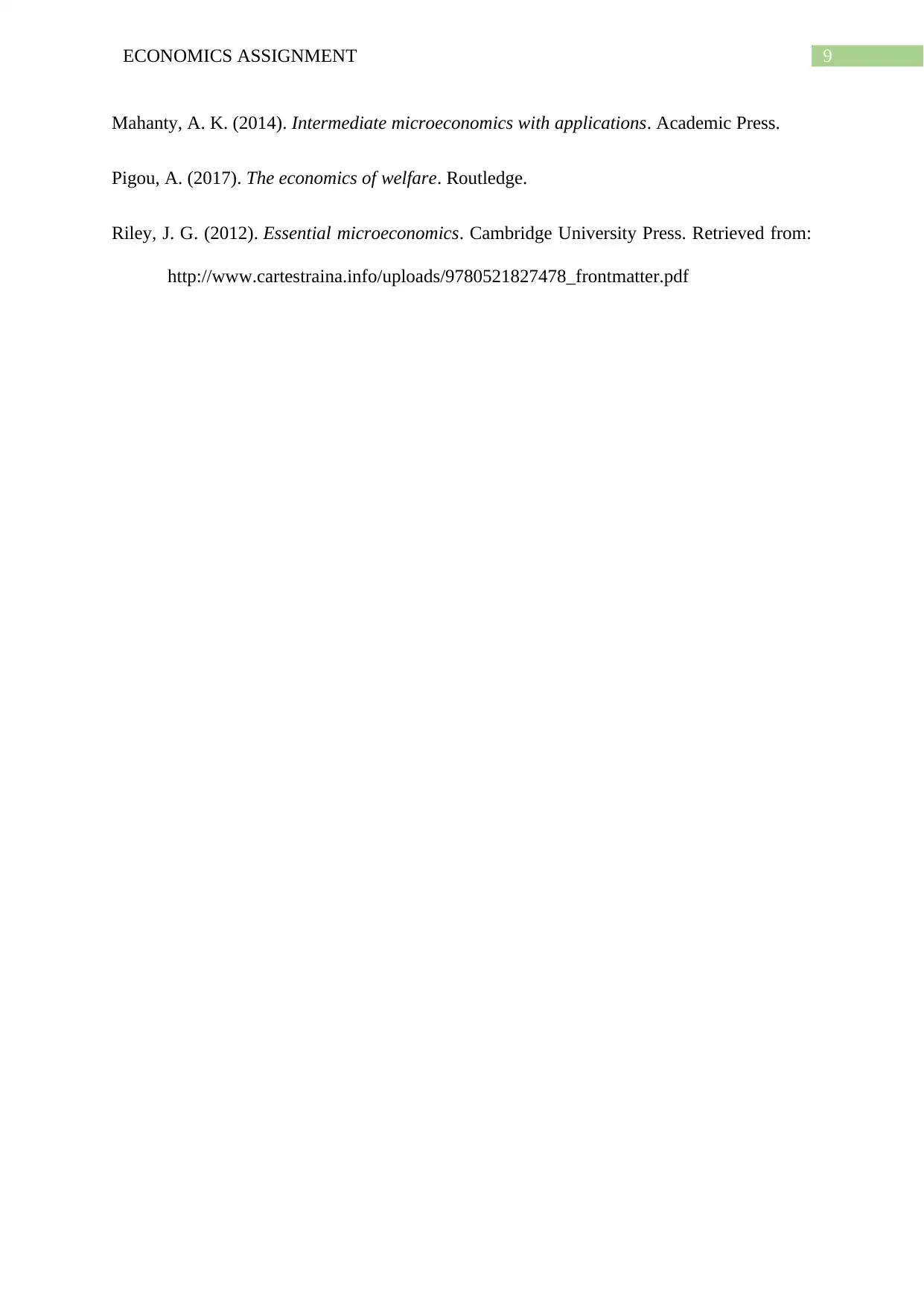
9ECONOMICS ASSIGNMENT
Mahanty, A. K. (2014). Intermediate microeconomics with applications. Academic Press.
Pigou, A. (2017). The economics of welfare. Routledge.
Riley, J. G. (2012). Essential microeconomics. Cambridge University Press. Retrieved from:
http://www.cartestraina.info/uploads/9780521827478_frontmatter.pdf
Mahanty, A. K. (2014). Intermediate microeconomics with applications. Academic Press.
Pigou, A. (2017). The economics of welfare. Routledge.
Riley, J. G. (2012). Essential microeconomics. Cambridge University Press. Retrieved from:
http://www.cartestraina.info/uploads/9780521827478_frontmatter.pdf
1 out of 10
Related Documents
Your All-in-One AI-Powered Toolkit for Academic Success.
+13062052269
info@desklib.com
Available 24*7 on WhatsApp / Email
![[object Object]](/_next/static/media/star-bottom.7253800d.svg)
Unlock your academic potential
Copyright © 2020–2025 A2Z Services. All Rights Reserved. Developed and managed by ZUCOL.





